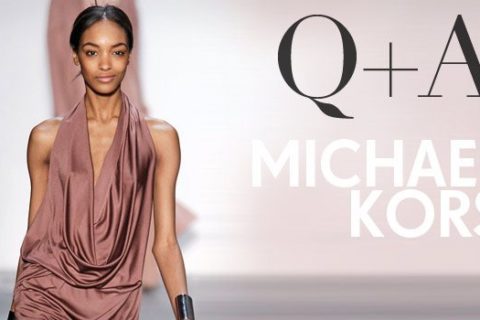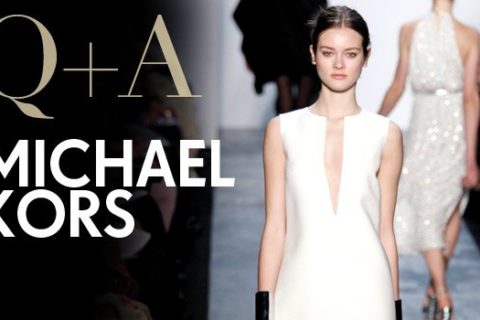Q&A: Michael Kors looks back at his 30-year career—the trends, the tears, and the trunk shows


Michael Kors on celebrating his 30th anniversary, staying plugged in and becoming an adjective.
All-American. Spirited. Jetsetter. You can spot Michael Kors from a mile away. Over the course of his 30 years in the fashion industry, the man and the brand have become one and the same, morphing into a mega-empire that, as rumour has it, hit a billion dollars in sales this year. Not bad for a boy from Long Island, New York. Adored by Hollywood A-listers like Gwyneth Paltrow and Jennifer Lopez, soccer moms and First Ladies alike (Michelle Obama wore Kors for her first official White House portrait), his rise to fashion royalty took off in 1981, when he launched his eponymous womenswear line.
Soon after came a menswear label, a first fragrance, an accessories collection, multiple awards, a stint as creative director at Céline, more fragrances, two bridge lines (Kors Michael Kors and Michael Michael Kors) and countless stores dotting the globe, including a new flagship store on Bloor Street West in Toronto. He’s even managed to bring an end to the gasps that traditionally followed certain (dirty) fashion words like “accessible” and “wearable.”
Today, at 52, Kors continues to create magic, both on and off the runway. In celebration of his label’s 30th anniversary, he churned out a spectacular Fall 2011 retrospective show. And with those infamous biting quips (“She looks like an Amish cocktail waitress”), he’s a favourite judge on the reality TV show Project Runway. All while looking as cool and carefree as his collection.
Has the Michael Kors girl changed over the years?
“The first thing that was ever written about me was by Anna Wintour. The quote from me was: ‘I plan to keep my collection luxurious, spare, comfortable and sexy.’ Obviously, I’m a man who likes to stick to his guns. The look has evolved, but I’ve been pretty consistent in my message over the 30 years that I’ve been doing this. The customer has definitely changed. If you said people would wear sequins for day, or you could live in Toronto and wear strapless in the winter, or live in Miami and wear boots, people would have said that’s crazy. The girl who has always interested me is someone who is a bit of a dichotomy: She’s a sexy tomboy, she’s strong, she’s opinionated, she loves fashion, but she’s never going to be a fashion victim. The reality is, though, that we have customers who are 14, who are 45, who are 55 and who are 80. Age is no longer an issue. And even size—we see customers of every size and type.”

You’ve expanded into e-commerce but you’ve always been known for your trunk shows. Do they still produce results?
“The reality is that for any designer to be good at what they do, they have to live in the world. If you lock yourself in your design studio, you lose all touch with how people really live. So for me, it’s not only a trunk show. It’s travel, it’s being out, even when it’s impromptu. I’ll walk into my stores, find out what’s going on, watch girls on the street—all of that keeps you plugged in.”
So you enjoy public appearances?
“I love doing it! No matter how fun it is to see clothes on a runway model, there’s nothing better than seeing them come to life on a real person. Even with celebrities, I’m just as excited, if not more, to see someone in the public eye wearing Michael Kors. It could be Angelina Jolie taking her kids to a water park or Jennifer Aniston doing errands. If they look great and are able to live their lives without having their clothes get in the way, then I know I did my job.”
Who was your original Kors girl?
“I’ve always admired Lauren Hutton and Ali MacGraw—sporty, sexy, American women. I still dress both of them and I’m friends with them. And, of course, for most designers who are men, your mother will always be an influence. My mom has always been [that], but also kind of a muse. She has a sort of sporty, low-key style of dressing and has always dressed that way.”
Back in the early days, what kept you up at night?
“Every day was a learning curve. My first few seasons, I had people selling in my apartment, I was shipping the clothes myself. I remember driving up to Bergdorf’s to make a delivery on the last day. I had to get the clothes there on time.”
And these days?
“My brain never stops, unless I’m on vacation on a beach somewhere for a long period of time. You’re always thinking about it.”
Why did you have your 30th anniversary party in Paris?
“Actually, we had three. We had a surprise party backstage before the show in New York that I knew nothing about. Bette Midler arrived with her ukulele, singing ‘Happy Anniversary.’ My favourite place in New York has always been the Carlyle’s Bemelmans Bar. We wanted to do something glamorous but informal there. And then [there was] Paris. When I first started, the last thing that any American designer ever thought was that you were going to someday have a fashion show in Paris and spend time working [there]. I spent seven and a half years at Céline as the creative director and truly fell in love with Paris. To be able to celebrate in a city where I spent a lot of time is a homecoming, and it commemorated our largest store opening in the world.”

Has turning 30 been an emotional experience?
“I didn’t think it was going to be, but the night before the fall show, the last fitting was with Carmen Kass. She tried on the evening gown that was going to close and when she started walking for me in the dress, I started crying. I was realizing how long we’ve worked together and how many shows she’s opened and closed for me. Paris was really to thank all of the people who have been such a part of my career: the models, the editors, the retailers. In fashion, it takes a city, not a village.”
You have been loyal to many of your runway and campaign girls. Why has this been important to you?
“I have never dressed a model—and I still don’t—like she’s a mannequin. I really try to get to know the girl. Beauty with a model is a given, but when someone has their own style and personality, they add their own spin. I’ve known Karolina Kurkova and Isabeli [Fontana] since they were 15. I’ve watched them become moms and wives. It’s wonderful to see them grown. I think they’ve become even more fabulous.”
Your shows always have that feel-good factor. You leave feeling energized and happy. Is this your personality too?
“I would say most of the time I am. The biggest mistake that fashion can sometimes present to the world is that if you’re chic, you have to be funereal and sombre, and if you like to have a good time and smile, that means you have no sense of style and you’re a goofball. I believe you can have both; men love a woman who can laugh.”
What was the starting point for your fall 2011 collection?
“I thought, ‘You know what? Thirty years entitles you to use yourself as an adjective.’ It’s okay for me to say, ‘That’s very Michael Kors.’ I thought about the decades that I have been designing clothes in, and what the best things were about those decades. The ’70s was the sporty decadence. I liked the athleticism and the power of the ’80s—without the shoulder pads and the Dynasty. The ’90s were, to me, all about quality, simplicity, understatement. When we went into the aughties, it was about exuberance and glamour.”
Accessories play a huge role in your collections, but looking at your own sense of style, would you say you’re a minimalist?
“I think you can’t be focused and pared-down unless you’ve been trendy. When I was a teenager, I wore crazy boots and hats and glasses. Once I started designing, the last thing I wanted to think about was getting dressed for myself. I’ve been wearing aviator sunglasses for over 30 years now, a huge chunky watch, a black T-shirt, a black jacket and white or dark jeans. I can go anywhere in the world and I don’t have to think about what I’m wearing because I spend my time thinking about what everyone else is.”







